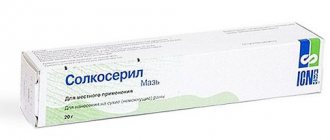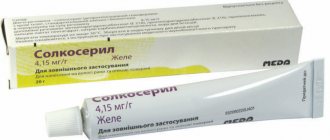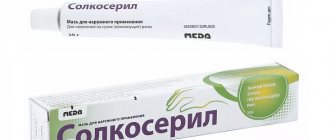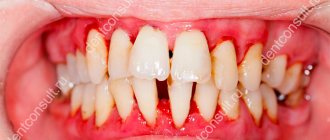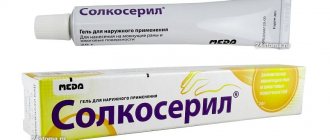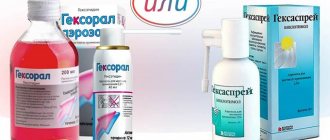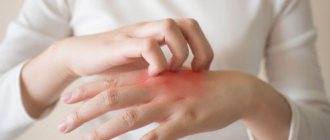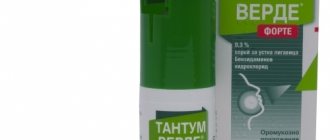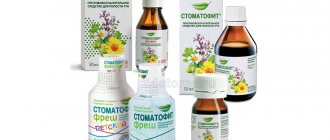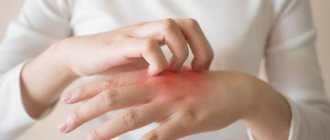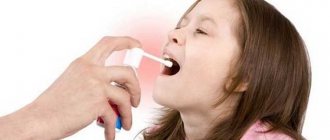Which analogue is better to choose
There are other analogues of Korneregel. All of them are aimed at treating almost the same diseases or eye injuries, but the difference between them is as follows:
- Price. Some products are more expensive, some are cheaper.
- Release form. Cost may vary depending on whether the drug is an ointment, gel, powder, or solution.
- Indications for use. The more often you take the drug, the more you may need, which will also affect its cost.
There is no definite statement as to which remedy is the best. It all also depends on the human body, which is sometimes not able to take this drug. That is why in any case it is necessary to seek advice from an ophthalmologist.
special instructions
You should not put Solcoseryl dental adhesive paste into the wound cavity formed as a result of the removal of molars, wisdom teeth, as well as apicotomy (resection of the apex of the tooth), if the edges of the tooth socket are tightened with subsequent sutures.
Solcoseryl dental adhesive paste does not contain anti-infective components. In case of acute infection of the affected area of the oral mucosa, which is subject to treatment with this drug, it is necessary to carry out preliminary medical treatment/treatment of the affected area aimed at eliminating the symptoms of inflammation.
Solcoseryl gel: instructions and application diagram
For Solcoseryl-gel, the instructions for use contain information that the drug has the following types of pharmacological effects when applied to the skin or mucous membrane of the oral cavity - antihypoxic, cytoprotective, regenerating, membrane stabilizing, angioprotective, wound healing. In simple terms, this means that the drug has the following properties -
- increases regenerative processes (accelerating tissue regeneration by approximately 30%),
- stimulates collagen synthesis,
- stimulates cell division (reproduction),
- promotes activation of metabolic processes in cells (increases oxygen consumption by cells, and also stimulates the transport of glucose into cells), which allows damaged cells of the body to recover faster.
Solcoseryl gel: official instructions for use (download in PDF)
Application for treating skin wounds –
Solcoseryl in gel form is intended only for the treatment of fresh, wet wounds, i.e. wounds that have wet discharge. If your wound is already covered with crusts and does not have a wet discharge, you need to use solcoseryl in the form of an ointment. A very important point is that the gel cannot be applied to wounds with purulent discharge (in this case, you first need to have the wound surgically treated by a doctor). In addition, if the wound has torn edges, then surgical treatment is also necessary, without which the wound will quickly fester.
The gel can be applied to wet wounds if the discharged liquid is clear or includes a small amount of blood (i.e., it is “ichor”). But even in these cases, before applying the gel, the wound must be treated with an antiseptic - best using a sterile gauze swab generously moistened with 3% hydrogen peroxide. After antiseptic treatment with another sterile gauze swab, you need to remove excess moisture from the wound and apply a thin layer of gel.
This two-stage treatment should be carried out 2-3 times a day until the wound is covered with granulation tissue and begins to dry out. After this, you need to start using Solcoseryl in the form of an ointment, which is intended specifically for dry wounds on the skin.
Application of gel in the oral cavity –
If you have developed shallow erosions/ulcers due to stomatitis or wearing removable dentures, Solcoseryl gel will be an excellent remedy. If you have a deep ulcer, then it is better to use this drug not in the form of a gel, but Solcoseryl in the form of a dental paste, which, in addition to accelerating healing, also has the function of a protective therapeutic dressing.
You can also use the gel in the mouth 2-3 times a day, making sure to rinse your mouth before using this antiseptic solution. The choice of antiseptic will depend on the cause of the disease. For example, for erosions and ulcers due to herpetic stomatitis, you need to rinse your mouth with a solution of Miramistin, which is active against the herpes virus. In all other cases, it is better to use the antiseptic Chlorhexidine. How to use these antiseptics correctly - see the links below.
After rinsing your mouth, you need to dry the mucous membrane at the site where the gel is applied with a clean, dry gauze swab (in this case, the gel will stick better), and then, without rubbing, simply apply the gel using a clean finger. If we are talking about treating bedsores under prostheses, then immediately after applying the gel you need to put on the prosthesis.
→ Regimen for the use of Chlorhexidine → Regimen for the use of Miramistin
Important: it is advisable to treat the mucous membrane with gel immediately after eating and subsequent oral hygiene. In the absence of good hygiene, a bacterial infection can join wounds and ulcers on the oral mucosa, causing inflammation. After brushing your teeth, you can rinse your mouth with an antiseptic and apply the gel.
Next, it is advisable not to eat or rinse your mouth for 2-3 hours; you can drink
After brushing your teeth, you can rinse your mouth with an antiseptic and apply the gel. Next, it is advisable not to eat or rinse your mouth for 2-3 hours; you can drink.
What types are there?
Previously, Solcoseryl was produced only in the form of an ointment, but the manufacturer has significantly expanded its product range:
- Gel. To fix the gel on the mucous membrane, you need to thoroughly treat the desired area with an antimicrobial agent, then wipe it dry with sterile gauze.
- Paste. Perhaps this is the most successful option, ideal for use within the oral cavity. The paste does not spread and holds well; it is often prescribed by dentists for the treatment of gums.
- Ointment. Solcoseryl in ointment form is not used for dental purposes. Due to its too greasy consistency, the product instantly spreads over the gums and is washed off with saliva. This option is most suitable for treating skin.
- Pills. They are used for oral administration for ulcerative lesions of the mucous membrane or for rapid tissue regeneration, for example, after a complex tooth extraction.
Instructions for use
Before you start using this or that dosage form, you should carefully read the instructions in the box with the medicine and consult a specialist.
- Ointment. Apply a thin layer to areas where epithelization has begun twice a day. It is recommended to apply the ointment under the bandage. Continue treatment until complete healing and the appearance of an elastic scar. In case of severe trophic disorders, it is advisable to combine the ointment with a solution for parenteral administration.
- Gel. Apply to fresh wounds with oozing and copious discharge after cleansing 3 times a day. Continue treatment until tissue epithelization begins.
- Injection. The method of administration to the body is intravenous drip. The contents of the ampoule are introduced into a 250 ml bottle. saline sodium chloride solution or 5% glucose. It is also allowed to administer 1 ampoule intramuscularly. Doses vary depending on the indication:
| Traumatic brain injury, stroke, encephalopathy | 3 ampoules three times a day intravenously for 10 days. Subsequently, 1 ampoule IM for 30 days. |
| Peripheral artery disease, heart disease | 5 ampoules twice a day intravenously very slowly for a month |
| Venous insufficiency | 2 ampoules 2 times a day intravenously for no more than a month. In parallel, it is recommended to use ointment and gel. |
- Dental paste. Use topically on the oral mucosa. Before applying the paste, you need to dry the mucous membrane with a cotton ball or gauze ball. Lubricate the affected area with Solcoseryl and moisten with water.
- Eye gel. Before use, wash your hands and maintain sterility. Place 1 drop in the eyeball area 4-5 times a day. For severe corneal injuries, the procedure is allowed to be performed every hour. Do not mix with other eye drops, maintain an interval of at least 20 minutes. Do not use soft contact lenses.
Nosological classification (ICD-10)
- K05.0 Acute gingivitis
- K05.1 Chronic gingivitis
- K05.3 Chronic periodontitis
- K05.6 Periodontal disease, unspecified
- K06 Other changes in the gingiva and edentulous alveolar margin
- K12 Stomatitis and related lesions
- K12.0 Recurrent oral aphthae
- K13.0 Diseases of the lips
- K13.7 Other and unspecified lesions of the oral mucosa
- Z96.5 Presence of dental and jaw root implants
- Z97.2 Presence of dental prosthetic device (complete) (partial)
Pharmacological action and pharmacokinetics
Solcoseryl injection, intended to improve blood composition and prevent cellular degeneration, after administration has the following effect on the body:
- prevents oxygen starvation of cells, provides them with nutritional phosphates, thereby maintaining a high metabolic rate;
- hemoderivat improves the transport of sugar from blood plasma to soft tissues suffering from ischemic processes and hypoxia;
- increases the rate of cellular regeneration of damaged areas;
- prevents the development of cell degeneration and pathological processes in tissues that arise as a result of dystrophy (malnutrition);
- stimulates the synthesis of collagen fibers in the subcutaneous tissue;
- increases the rate of cell division and migration.
Thanks to this effect, Solcoseryl protects soft tissues that do not receive enough oxygen and energy resources from necrosis. The medicine is necessary to accelerate regeneration and prevent ischemia.
Protein-free dialysate is a mixture of many molecules removed from animals, so it is impossible to monitor their distribution throughout the body. During preclinical trials, it was found that the therapeutic effect is achieved within 10-30 minutes after the injection. The active substance continues to work for about 3 hours, after which it breaks down in the liver into inactive metabolites and is excreted by the body through the urinary system.
Pharmacological characteristics of the drug
Solcoseryl is defined in as many as three pharmacological groups:
- antioxidants and antihypoxants;
- regenerative and reparative;
- angioprotective agents and corrective microcirculation in blood vessels.
The drug can have the following effects:
- Stimulates oxygen energy exchange in the cell and oxidative processes, while being a nutritional component.
- Eliminates secondary damage in cells.
- Counteracts fat peroxidation, nitrogen synthesis, removes free radicals;
- Triggers collagen synthesis and cell proliferation.
- Accelerates the transfer of glucose and oxygen to tissues suffering from hypoxia and depleted from lack of nutrients.
Pharmacodynamics
Solcoseryl is a chemically and biologically standardized deproteinized dialysate obtained from the blood of healthy dairy calves by ultrafiltration. Solcoseryl contains a wide range of natural low-molecular compounds weighing up to 5000 Da: glycolipids, nucleosides and nucleotides, amino acids, oligopeptides, trace elements, electrolytes, intermediate products of carbohydrate and fat metabolism. Solcoseryl activates the transport of oxygen and nutrients at the cellular level, increases oxygen consumption by the cell, stimulates ATP synthesis, enhances the proliferation of reversibly damaged cells, especially under hypoxic conditions, thereby accelerating wound healing processes. Solcoseryl stimulates angiogenesis, promotes revascularization of ischemic tissue, as well as the creation of conditions favorable for collagen synthesis and the growth of fresh granulation tissue, accelerates re-epithelialization and wound closure. Solcoseryl also has membrane-stabilizing and cytoprotective effects.
Polidocanol 600 - local anesthetic; acts in the area of peripheral nerve endings, causing their reversible blocking. It has a quick and long-lasting local anesthetic effect. After applying the paste to the oral mucosa, the pain stops within 2–5 minutes; pain relief lasts for 3–5 hours.
Solcoseryl dental adhesive paste forms a protective healing layer on the affected area of the oral mucosa and protects it from mechanical and chemical damage for 3–5 hours, performing the function of a medicinal bandage.
Characteristics of analogues
"Actovegin"
It is an Austrian drug made from the blood of young calves, in release form and action completely similar to the original
But it is important to understand that both of these drugs do not have anti-inflammatory and antibacterial properties, therefore, in the presence of wounds and ulcers, they should be used in combination with antiseptics or other agents that prevent infection
I am often asked whether it is really worth replacing Solcoseryl with Actovegin. In fact, the difference between these drugs is minimal, even in the concentration of the active component.
But sometimes, if one drug is intolerant, another is perceived normally. Perhaps this is a reaction to excipients.
"Adgelon"
A powerful and effective ophthalmic drug with powerful regenerating properties based on proteins. This is fundamentally different from Solcoseryl, in which they are completely absent. Accordingly, Adgelon can provoke severe allergies in people with intolerance to certain types of protein.
The drug stimulates the activity of fibroblasts, preventing the formation of scars, restores damaged cell membranes and even slows down the aging process.
At the same time, there are practically no contraindications to it. However, it is recommended for use for medicinal purposes, not cosmetic.
"Levomekol"
An inexpensive and very effective wound healing agent, which contains antibacterial components. Sometimes this ointment from a Russian manufacturer is recommended for use in the treatment of acne and inflamed acne. It does work in these cases, but should be used under the supervision of a dermatologist and in short courses.
Levomekol does not have rejuvenating and restorative properties, so its use for these purposes, especially on healthy skin, is completely pointless.
In addition, regular use will disrupt the natural microflora and make the face more vulnerable to pathogenic microorganisms.
"Methyluracil"
Also a Russian drug, its pharmacological action is so similar to Solcoseryl that even many doctors consider it an artificial analogue of the original. Naturally, with all the ensuing consequences: a large number of contraindications and an increased risk of allergic reactions.
But the ointment really does an excellent job of stimulating cell division and, when used correctly, significantly improves the condition of the skin. If there are open wounds, they must first be treated with an antiseptic, since there are no anti-inflammatory components in Methyluracil. I am pleasantly pleased with its price - only about 80 rubles per package.
Apropol
The main biological component of this wound-healing agent is the beekeeping product propolis. It has been used for medicinal purposes since ancient times, as it has antiseptic, anti-inflammatory, antifungal properties and is able to enhance immune defense.
The ointment can be classified as a natural stimulant - there are very few chemical components in it. When used externally, it gives an effect similar to Solcoseryl, but somewhat slower.
However, like any natural remedy, it works superficially, is not able to penetrate into the deep layers of the epidermis and significantly influence intracellular processes.
Composition and release form
| Paste for use in dentistry | 1 g |
| deproteinized dialysate from the blood of healthy dairy calves (Bos Taurus), chemically and biologically standardized (in terms of dry matter) | 2.125 mg |
| polidocanol 600 | 10 mg |
| preservatives | |
| Methyl parahydroxybenzoate (E218) | 1.8 mg |
| propyl parahydroxybenzoate (E216) | 0.2 mg |
| excipients: sodium carboxymethylcellulose - 22.875 mg; peppermint oil - 2.925 mg; menthol - 0.075 mg | |
| paste base: (sodium carboxymethylcellulose, gelatin, pectin, polyethylene 350000, liquid paraffin) - 960 mg |
in tubes of 5 g; 1 tube in a box.
Analogues of dental adhesive paste Solcoseryl
Basically, there is no need to look for a replacement for Solcoseryl. The paste is suitable for everyone, with the exception of those patients who have hypersensitivity to the components of the product.
Despite the fact that all drugs today have several substitutes, there are no 100% analogues of Solcoseryl dental paste.
Analogs of Solcoseryl dental paste are the following drugs:
- Vitadent gel is an anti-inflammatory drug, the main substance of which is oak bark extract, and is classified as a herbal preparation.
- Dicloran Denta gel - has an analgesic effect, the main active substance is diclofenac.
- Dologel ST gel is a combined antimicrobial and analgesic agent. Active ingredients: benzalkonium hydrochloride and choline salicylate.
- Mundizal gel is very close in its pharmacological properties and composition to Dologel ST gel. Does not contain sugar and can be prescribed to diabetics.
- OKI solution is available in liquid form for rinsing and as a spray. Contains ketoprofen.
- Proposol spray - available in the form of aerosols, due to the content of propolis it promotes the regeneration of cells of the oral mucosa.
- Salvin solution is a complex product with anti-inflammatory and tanning properties based on sage leaf extract.
- Stomatophyte liquid extract is an extract containing an alcoholic infusion of a complex of herbs (arnica herb, calamus rhizomes, peppermint leaves, sage leaves, oak bark, common thyme herb, chamomile flowers).
- Tantum Verde solution is a rinse liquid, the main active component of which is benzydamine hydrochloride.
- Cholisal gel is a dental gel containing choline salicylate, cetalkonium chloride. Has a strong anti-inflammatory and analgesic effect.
Solcoseryl for external use
All of the above drugs are available in pharmacies without a prescription, but you need to choose the best one after consultation with a dentist, based on the individual characteristics of the patient.
Solcoseryl
The drug solcoseryl is a deproteinized, chemically and biologically standardized hemodialysate obtained from the blood of dairy calves using the ultrafiltration method. A drug substance is a combination of many low-molecular components of the cell mass, including glycoproteins, nucleotides, nucleosides, amino acids, oligopeptides, electrolytes, microelements, intermediate products of lipid and carbohydrate metabolism. This drug activates tissue metabolism, stimulates the processes of cellular nutrition and restoration. Solcoseryl provides more active transport of oxygen, glucose and other nutrients to tissues under conditions of oxygen starvation, stimulates the synthesis of intracellular ATP, promotes the growth and reproduction of reversibly damaged cells (which is especially important under hypoxic conditions), accelerating wound healing. The drug triggers the formation of new blood vessels, promotes the restoration of blood vessels in ischemic tissues and the growth of fresh granulation tissue, creates favorable conditions for the synthesis of the main structural protein of the body - collagen, accelerates the growth of epithelium on the wound surface, resulting in wound closure. Solcoseryl is also endowed with cytoprotective and membrane-stabilizing effects.
The drug is available in five dosage forms: solution for intravenous and intramuscular administration, ophthalmic gel, paste for topical use, gel and ointment for external use. The protective effect of the eye gel is to stimulate re-epithelialization of the cornea after various damaging effects on it: these can be chemical burns (for example, alkali), mechanical injuries, inflammatory processes. In addition to the active substance, this dosage form contains sodium carmellose, which ensures uniform and long-lasting coverage of the cornea, so that the affected area of tissue is uninterruptedly saturated with the drug.
Eye gel is the only dosage form of solcoseryl that has restrictions for use in cases of engaging in potentially hazardous activities (driving a car, working in production): in such cases, after applying the gel to the cornea, it is necessary to suspend your activity for 20-30 minutes.
An additional component of solcoseryl dental adhesive paste is polidocanol 600, a local anesthetic whose action is realized at the level of peripheral nerve endings, causing their temporary blocking. This substance has a quick and long-lasting local analgesic effect. After applying dental paste to the oral mucosa, the pain stops after 2-5 minutes, and this effect persists for another 3-5 hours. Solcoseryl dental paste forms a protective healing layer on the affected area of the oral mucosa and effectively protects it from various types of damage. Meanwhile, this dosage form has a number of restrictions for use: for example, it is not recommended to put it into the cavity formed after the removal of wisdom teeth, molars and resection of the apex of the tooth (in the latter case, if sutures are applied after tightening the edges of the socket). The paste does not contain antibacterial components, therefore, in case of infection of the oral mucosa, before using solcoseryl, it is necessary to carry out a preventive medicinal “cleansing” in order to eliminate the causative agent of the infection and relieve inflammatory symptoms.
Solcoseryl gel for topical use is easily washed off from wound surfaces, because... does not contain fats as excipients. It promotes the formation of young connective (granulation) tissue and the resorption of exudate. From the moment fresh granulations form and the affected areas dry out, it is recommended to use solcoseryl in the form of an ointment, which, unlike the gel, already contains fats that form a protective film on the wound.
Instructions for use
The doctor takes into account which form of release to prescribe, depending on the affected organ.
The medication can be used externally on the skin, cornea, gums or by injection.
Solcoseryl in cosmetology
Used for the face - applied to the skin.
Before the first application, a hypersensitivity test should be done. This procedure will avoid an allergic reaction.
To do this, a small amount of medication is applied to the wrist.
After half an hour, you should evaluate the condition: is there any rash, itching or redness.
If no allergies are detected, you need to follow the step-by-step steps:
- Remove makeup, remove residual impurities with micellar water or other cleansers.
- Hold your face over the steam for 5 minutes or apply a towel dipped in hot water to it.
- Apply the preparation to the skin of the face and décolleté, moving from the central to the peripheral area.
- Keep the ointment for about half an hour.
- If a burning or tingling sensation is felt, Solcoseryl should be washed off immediately.
- After the time has passed, remove the medication with a cotton pad and cleanser.
It is advisable to perform the procedure before going to bed.
You should not leave the house earlier than two hours after removing the ointment.
The procedure should be carried out 2 times a week for 1 month.
Wrinkle care instructions:
- Remove makeup.
- Using light finger pressure, distribute the product under the eyes.
- Using loop-like movements, distribute the preparation from the outer corner of the eyebrows to the inner corner of the eye.
- If there is excess ointment, soak it with a paper towel.
It is advisable to perform this procedure twice a week before going to bed.
The product effectively eliminates crow's feet.
Eye gel
To apply the drug, pull down the lower eyelid.
A little gel (the size of a pea) is placed in the resulting “pocket”.
Depending on the course of the pathology, the frequency of use differs:
In acute cases, the doctor recommends taking the medication up to 10 times a day. When severe symptoms subside, Solcoseryl is applied up to four times a day.
- If the ophthalmologist prescribes the gel along with other eye drops, they must be used 10 minutes apart.
- If the doctor prescribes a medicine as an adaptation to contact correction devices, the drug must be applied before installation and after their removal.
After each procedure, it is recommended to treat the “spout” of the tube with an antiseptic solution. The gel should be stored in a cool place.
Dental paste
The medicine is intended for the gums.
The affected area is pre-dried with a gauze pad. Then apply dental paste (about 0.5 cm long). It cannot be rubbed in.
After this, the patient should moisten the product with water.
The procedure is carried out up to five times a day after meals and before bedtime. Therapy lasts until the symptoms of the disease disappear.
Dental ointment forms a protective layer on the mucous membrane that prevents mechanical or chemical damage for up to five hours.
If the drug is prescribed to combat bedsores from removable prosthetics, it must be applied to a dry structure. After this, the medicine is moistened with water.
Application of ampoules
The solution can be prescribed for intramuscular or intravenous injections.
2 ml of the product is administered once a day.
The duration of therapy ranges from ten days to 6 months and depends on the doctor’s prescription.
Solcoseryl dental adhesive paste for topical use, 5 g
Registration Certificate Holder
MEDA PHARMACEUTICALS SWITZERLAND (Switzerland)
Dosage form
Medicine - Solcoseryl dental adhesive paste
Description
Paste for topical use
in the form of a pale beige mass, granular, homogeneous, easily distributed, with the smell of peppermint.
1 g
standardized deproteinized dialysate from the blood of healthy dairy calves (in terms of dry matter) 2.125 mg lauromacrogol 400 (polidocanol 600) 10 mg
Preservatives:
methyl parahydroxybenzoate (E218), propyl parahydroxybenzoate (E216).
Excipients
: sodium carboxymethylcellulose, peppermint oil, menthol.
Paste base:
sodium carboxymethylcellulose, gelatin, pectin, polyethylene 350,000, liquid paraffin.
5 g - aluminum tubes (1) - cardboard packs.
Indications
For topical use in patients of all age groups to accelerate healing, relieve pain and protect the wound surface in the following diseases and conditions:
- gingivitis and periodontal diseases, incl. after surgical interventions, installation of implants, removal of tartar;
- bedsores from removable dentures during the period of adaptation to them;
- alveolitis;
- stomatitis;
- lesions of the oral mucosa due to pemphigus;
- aphthae;
- jams.
Contraindications for use
- hypersensitivity to the components of the drug, including free parahydrobenzoic acid (E 210), the presence of a residual amount of which is due to the peculiarities of the technological process during the production of the drug.
pharmachologic effect
Combined preparation for local use, stimulator of tissue regeneration.
The drug is a chemically and biologically standardized deproteinized dialysate obtained from the blood of healthy dairy calves using the ultrafiltration method. Contains a wide range of natural low-molecular compounds weighing up to 5000 Daltons: glycolipids, nucleosides and nucleotides, amino acids, oligopeptides, trace elements, electrolytes, intermediate products of carbohydrate and fat metabolism. Activates the transport of oxygen and nutrients at the cellular level, increases oxygen consumption by the cell, stimulates ATP synthesis, enhances the proliferation of reversibly damaged cells, especially under hypoxic conditions, thereby accelerating wound healing processes. Stimulates angiogenesis, promotes revascularization of ischemic tissue, as well as creating conditions favorable for collagen synthesis and the growth of fresh granulation tissue, accelerates re-epithelialization and wound closure. The drug also has membrane-stabilizing and cytoprotective effects.
Polidocanol 600 - local anesthetic; acts in the area of peripheral nerve endings, causing their reversible blocking. It has a quick and long-lasting local anesthetic effect. After applying the paste to the oral mucosa, the pain stops within 2-5 minutes; pain relief lasts for 3-5 hours.
Solcoseryl dental adhesive paste forms a protective healing layer on the affected area of the oral mucosa and protects it from mechanical and chemical damage for 3-5 hours, performing the function of a medicinal bandage.
Drug interactions
To date, there have been no cases of interaction between Solcoseryl dental adhesive paste and other drugs.
When simultaneously prescribing Solcoseryl dental adhesive paste and other drugs in the form of rinses, the paste should be applied after using these drugs.
Dosage regimen
The drug is intended for local use on the oral mucosa.
The affected surface of the mucous membrane must first be dried with a cotton or gauze swab. Apply a strip of paste about 0.5 cm long, without rubbing, onto the mucous membrane in a thin layer with your finger or using a cotton swab, and then lightly moisten the applied paste with water. The procedure is repeated 3-5 times a day after meals and before bedtime. Treatment is carried out until symptoms disappear.
Solcoseryl dental adhesive paste forms a protective therapeutic layer on the affected area of the oral mucosa and protects it from mechanical and chemical damage for 3-5 hours. When applying the paste to undried mucosa, the duration of the therapeutic effect can be reduced.
When treating bedsores from removable dentures, apply the paste to a dry denture and moisten with water.
The recommended course dose of the drug is 1 tube (5 g).
Overdose
There is no information on the effects of an overdose of the drug.
Side effect
Local reactions:
change in taste sensations; Allergic reactions (local swelling) are possible; if these occur, the patient should stop using the drug and consult a doctor.
special instructions
You should not put Solcoseryl dental adhesive paste into the wound cavity formed as a result of the removal of molars, wisdom teeth, as well as apicotomy (resection of the apex of the tooth), if the edges of the tooth socket are tightened with subsequent sutures.
Solcoseryl dental adhesive paste does not contain antimicrobial components. In case of acute infection of the affected area of the oral mucosa, which is subject to treatment with this drug, it is necessary to carry out preliminary medical treatment/treatment of the affected area aimed at eliminating the symptoms of inflammation.
There are no restrictions regarding the use of the drug in elderly patients.
Use in pediatrics
There are no restrictions on the use of the drug in children.
Storage conditions
The drug should be stored out of the reach of children at a temperature not exceeding 30°C.
Best before date
Shelf life: 4 years.
The granular-dry consistency of the paste ensures its optimal adhesive properties and is not a sign of deterioration in the quality of the drug. When opening the tube, oil may be released, which is also not a sign of deterioration in the quality of the drug.
Use during pregnancy and breastfeeding
Restrictions during pregnancy - With caution. Restrictions when breastfeeding - With caution.
There are no contraindications to the use of Solcoseryl dental adhesive paste during pregnancy and lactation (breastfeeding), although special controlled studies on the safety of the drug in women during pregnancy and lactation have not been conducted.
Use in elderly patients
Restrictions for elderly patients - No restrictions.
There are no restrictions regarding the use of the drug in elderly patients.
Use in children
Restrictions for children - No restrictions.
There are no restrictions regarding the use of the drug in children.
Terms of sale
The drug is approved for use as a means of OTC.
Contacts for inquiries
MYLAN PHARMA LLC (Russia)
109028 Moscow, Serebryanicheskaya embankment. 29 Business North Side, fl. 9 Tel. Fax
Instructions for use
Solcoseryl droppers are given to ensure a lasting therapeutic effect and reduce the likelihood of adverse reactions. If the patient's condition does not allow for infusion, injections are administered intravenously. In the latter case, the medication is diluted with saline or 5% glucose solution in a 1:1 ratio. The injection is administered slowly over 2 minutes to prevent an increase in the concentration of potassium in the blood plasma. When the volume of the diluted drug exceeds 40 ml, droppers are placed.
Treatment regimens and dosage
The dosage and method of administration of the drug depend on the goals of treatment and the type of disease:
- Pathologies of peripheral arteries 2 degrees. The medication is administered as an infusion of 250 ml per day at a rate of 20-40 drops/min. Drug therapy continues for 20 days. If the disease has reached stage 3, injections are given at a dosage of 20 ml.
- Trophic ulcers, burns, bedsores. After the injections, a dressing is carried out soaked in Solcoseryl ointment to enhance tissue regeneration. When the patient's condition improves, the injections are stopped. The dosage is not indicated, because it depends on the area of the skin affected. For chemical burns, a single injection of the drug with a volume of 20-50 ml is carried out.
- Varicose veins with severe tissue trophic disorders. Injections are made into a vein 3 times a week, 10 ml. The course of therapy lasts 4 weeks.
- Ulcerative lesions of the digestive system. The drug is administered intramuscularly once a day, 20 mg of the active substance.
- Cerebral circulation disorders, traumatic brain injuries. The course of treatment is 10 days, the patient receives 10 to 20 ml of medication daily. After this, within a month the dosage of the drug is reduced to 2 ml per day.
- Prevention of ischemia. 5 mg of active substance is excreted per day.
- Disorders of the female reproductive system. Droppers of 250 ml are given for an hour.
When it is impossible to administer the drug intravenously, injections are given into the deep layers of muscles. In this case, the dosage of the solution should not be more than 2 ml per day. This limitation is due to the high risk of developing allergies, which are accompanied by rashes and severe itching. Swelling remains at the injection site for 2-3 days.
How to administer the drug
The drug is administered intravenously or in the form of injections. On average, therapy lasts about 4 weeks. The first 7-10 days require intensive treatment with Solcoseryl, after which the daily dose of the drug is gradually reduced. You should not suddenly switch to a lower dose to avoid the development of unwanted reactions.
Overdose and side effects
Cases of drug overdose have not been registered at the stage of preclinical studies. The injection solution does not put a strain on the functioning of internal organs and systems, so in most cases it is tolerated normally. The following side effects occur rarely:
- Allergy. If tissues are hypersensitive to the hemoderivative, rash, itching and urticaria develop.
- Increased body temperature.
- General reactions. Swelling at the injection site, the appearance of red spots and bruises on the skin, a burning sensation.
Composition of the drug Solcoseryl gel
The main actions of Solcoseryl gum gel are based on its active ingredient - deproteinized dialysate from the blood of healthy dairy calves, a natural component. Its dosage in 1 gram of medication is 4.15 mg.
If you squeeze out the drug, you will see that it is a transparent, homogeneous gel-like substance. It has a slight smell of meat broth and a dense consistency. It contains no preservatives or harmful toxic substances.
Also, the properties of the drug are provided by the additional components included.
| Gel Solcoseryl | Solcoseryl ointment |
| methyl parahydroxybenzoate | |
| propyl parahydroxybenzoate | |
| water for injections | |
| calcium lactate pentahydrate | white Vaseline |
| propylene glycol | cholesterol |
| carmellose sodium | cetyl alcohol |
Another form of release of Solcoseryl is dental paste. It additionally contains preservatives.
What is the difference between the composition of the ointment
Solcoseryl ointment is also based on dialysate. However, its concentration is 2 times less than in the gel. 1 gram of medication contains 2.07 mg of the main component.
Another difference is the included additional components. They provide a homogeneous, greasy mass of ointment. The smell of the medicine is mixed - a light meat aroma with Vaseline.
pharmachologic effect
According to the instructions, the medication belongs to the group of drugs that improve nutrition and healing of damaged gum tissue. The main substance contains many useful substances (amino acids, nucleotides, nucleosides, etc.).
The gel has the following properties:
- during hypoxia, it helps restore the transport of oxygen and glucose to damaged cells;
- improves oxidation and reduction processes occurring in tissues;
- improves regeneration and healing of damage;
- promotes rapid collagen production.
At the very beginning of therapy, it is recommended to use Solcoseryl in gel form. It has a light, gel texture, does not contain fats and is easily washed off. After application, the gel promotes the formation of so-called granulation tissue of the gums (young connective tissue) and the removal of fluid formed during the inflammatory process.
When granulation gum tissue has formed, fluid (exudate) has been removed and the wound begins to dry out, dentists prescribe medication in the form of an ointment. Thanks to a different base, it forms a protective film on the damaged surface.
pharmachologic effect
Combined preparation for local use, stimulator of tissue regeneration.
The drug is a chemically and biologically standardized deproteinized dialysate obtained from the blood of healthy dairy calves using the ultrafiltration method. Contains a wide range of natural low-molecular compounds weighing up to 5000 Daltons: glycolipids, nucleosides and nucleotides, amino acids, oligopeptides, trace elements, electrolytes, intermediate products of carbohydrate and fat metabolism. Activates the transport of oxygen and nutrients at the cellular level, increases oxygen consumption by the cell, stimulates ATP synthesis, enhances the proliferation of reversibly damaged cells, especially under hypoxic conditions, thereby accelerating wound healing processes. Stimulates angiogenesis, promotes revascularization of ischemic tissue, as well as creating conditions favorable for collagen synthesis and the growth of fresh granulation tissue, accelerates re-epithelialization and wound closure. The drug also has membrane-stabilizing and cytoprotective effects.
Polidocanol 600 - local anesthetic; acts in the area of peripheral nerve endings, causing their reversible blocking. It has a quick and long-lasting local anesthetic effect. After applying the paste to the oral mucosa, the pain stops within 2-5 minutes; pain relief lasts for 3-5 hours.
Solcoseryl dental adhesive paste forms a protective healing layer on the affected area of the oral mucosa and protects it from mechanical and chemical damage for 3-5 hours, performing the function of a medicinal bandage.
Injectable form of the drug
The use of Solcoseryl solution for hemorrhoids is not used so often. This form of the drug not only gives local results, but also affects the very cause of the disease. The product is administered intravenously or intramuscularly. Its course use leads to an improvement in the condition of the vascular walls, normalization of blood circulation in the pelvis, and stimulation of the regenerative abilities of tissues.
The treatment regimen is determined by the doctor and most often takes the form of one of the following approaches:
- The product is administered intravenously, pre-diluted in saline or 5% glucose. Manipulations are carried out three times a week. The duration of the course is determined by the doctor.
- The drug is administered daily in the form of intramuscular injections. The drug is also first diluted in glucose or saline. Therapeutic effects can last up to 4-5 weeks.
You should not count on the fact that with the help of Solcoseryl alone you will be able to completely and quickly get rid of hemorrhoids. With all its advantages and strengths, the product is only an auxiliary means of complex therapy of the disease. People with a chronic form of the disease are recommended to use the drug for preventive purposes from time to time, this will reduce the likelihood of relapse.
During the recovery period after surgical removal of hemorrhagic nodes, the use of the composition will accelerate tissue healing and prevent new stretching of the vascular walls. All of the above manipulations should be carried out only under the supervision of a doctor against the background of regular monitoring of positive dynamics.
During the recovery period after surgical removal of hemorrhagic nodes, the use of the composition will accelerate tissue healing and prevent new stretching of the vascular walls. All of the above manipulations should be carried out only under the supervision of a doctor against the background of regular monitoring of positive dynamics.
Analogs
According to active substance
A drug with a similar composition is Actovegin. It differs from Solcoseryl in its higher concentration of the active substance.
Levosin
Active ingredients: methyluracil, sulfadimethoxine, trimecaine, chloramphenicol. The drug has anti-inflammatory, anesthetic, antibacterial and necrolytic (aimed at rejecting necrotic masses) properties. It is used to treat infected skin lesions - purulent wounds, difficult-to-heal ulcers, burns.
Release form: ointment. Soak sterile wipes with the product and loosely fill the wound with them. A slightly warmed ointment can be injected into purulent cavities through a catheter. The procedure is carried out daily until complete cleansing of purulent-necrotic particles.
Side effects: skin redness, burning sensation, rash, dermatitis, swelling are possible at the site of application.
Contraindications: hypersensitivity to substances in the drug.
Vishnevsky ointment
Active components – birch tar, xeroform. Castor oil provides better penetration of these substances and warming of tissues. The medicine exhibits antiseptic activity, is a local irritant, and promotes regeneration processes. Intended for the treatment of wounds, bedsores, ulcers, boils, frostbite, burns.
Release form: liniment. Apply a thin layer to the wound surface or apply a gauze bandage with liniment 2 times a day. When treating hemorrhoids, you can make tampons from gauze, soak them in ointment and insert them into the anus.
Side effects: allergic manifestations. Prolonged use may cause skin irritation.
Contraindications: individual intolerance to the components of the product. During pregnancy, lactation, and childhood requires consultation with a doctor.
Posterisan
The active ingredient is an inactivated culture of E. coli bacteria (microorganisms killed and preserved in liquefied phenol). The product is intended for use in the anorectal area. Increases local immunity, accelerates the restoration of the skin and mucous membrane in case of hemorrhoids, anal fissures and eczema, relieves inflammation and itching, and prevents bacterial infection.
Release form: ointment, rectal suppositories. Gently apply the drug to the affected area, rubbing in lightly. Use morning and evening for 5-7 days. In agreement with the doctor, it is possible to change the treatment regimen.
Side effects include allergic reactions: hives, itching, rashes, redness and irritation of the skin.
Contraindications: hypersensitivity, children's age. During pregnancy and lactation requires medical supervision.
Relief (Hemorrhoids)
Active ingredients: phenylephrine hydrochloride, shark liver oil. Constricts blood vessels, reducing blood flow to hemorrhoids, relieves inflammation and swelling. The drug also increases local immunity, stops bleeding and improves the healing of wounds, erosions and fissures in the anorectal area.
Release form: rectal suppositories, ointment. Apply the product to the cleansed affected area up to 4 times a day or introduce it into the anus using an applicator after bowel movements or an enema.
Side effects: hypersensitivity reactions are possible - skin redness, burning, swelling, rash. When using large doses, the development of hypercoagulation is likely - increased blood clotting.
Contraindications: granulocytopenia, thromboembolism, high activity of the blood coagulation system, individual intolerance
Use with caution in case of high blood pressure, cardiovascular diseases, hyperthyroidism, diabetes mellitus, urinary disorders, pregnancy, lactation, under the age of 12 years
How to use it correctly
To achieve maximum effect, you must carefully follow the instructions. As mentioned above, for the treatment of oral diseases it is best to use dental adhesive paste:
- You must first treat the gums with Miramistin or Chlogexidine.
- Using a bandage, lightly dry the mucous membrane.
- Squeeze a small amount of Solcoseryl (the size of a pea) onto your finger.
- Apply the paste to the desired area using rubbing movements.
- Try not to eat or drink for an hour.
- Repeat the procedure 3-4 times a day.
The drug has a powerful wound-healing effect; you can see the first results literally within a day.
What is Dimexide?
Dimexide is an anesthetic drug and is prescribed along with ointment for one reason: to relieve pain and improve the patient’s condition. It has also been proven that Dimexide is absorbed into the skin and blood faster, which cannot be said about Solcoseryl. If you mix the drugs, the absorption will improve.
In order to mix the ointment with the solution, you need to do the following:
- Squeeze the ointment into a clean shallow vase.
- One or two drops of Dimexide are added to the ointment no more
- Mix and apply to the affected area
In general, the drug Dimexide can also be used as an independent remedy, it has an anti-inflammatory effect, the liquid itself is oily and quickly penetrates the skin. The solution is completely safe, doctors say that if you lubricate the wounds in the mouth with the solution, it will not cause any harm, only the medicine will benefit. In general, it is non-toxic, so if you decide to use Dimexide and ointment together, do not be afraid, the mixed composition will not cause harm.
Quattrex
Quattrex helps to increase intellectual and emotional activity, improve memory, and increase concentration. Quattrex is also effective for asthenic and anxiety-neurotic conditions, worries, fear, anxiety, obsessive-compulsive neuroses, psychopathy; Quattrex is used in children to treat stuttering, enuresis, nervous tics; in elderly people, Quattrex is intended for the treatment of insomnia and nighttime restlessness. Prevention of stressful conditions, before operations or painful diagnostic tests. Quattrex is used as an adjuvant in the treatment of alcoholism to stop psychopathological and somatovegetative disorders during withdrawal syndrome. The drug can be used together with generally accepted detoxification agents for the treatment of alcoholic predilection and delirium. It is also prescribed for Meniere's disease, dizziness associated with dysfunction of the vestibular apparatus, and for the prevention of motion sickness. It is used in the complex treatment of women with osteochondrosis of the cervicothoracic spine and menopausal disorders.
Analogues of Solcoseryl: cheap and effective replacement drugs
Solcoseryl belongs to the group of tissue regeneration activators. The drug is produced in various dosage forms and is prescribed in dental, ophthalmological, surgical practice and cosmetology. Let's look at what cheap analogues and substitutes exist for the composition of this drug, and how to replace Solcoseryl ointment?
When is Solcoseryl prescribed?
Regular use of this medicine helps supply cells with oxygen and speed up metabolism, which has a positive effect on regenerative processes.
Due to its composition, Solcoseryl has no toxic effect and does not cause side effects.
In some cases, allergic reactions may occur, so there is a need to search for similar drugs with a different composition.
The medicine "Solcoseryl" is prescribed to patients with the following diseases:
- hemorrhoids and varicose veins;
- dysfunction of the brain;
- diabetes mellitus;
- trophic ulcers;
- damage to the cornea of the eyes;
- stomatitis.
Wounds (mostly only immediately after their appearance and not soaking), burns and scratches are also something that can be treated with the use of the drug "Solcoseryl". Analogs of this drug are also often used for these purposes. Intravenously, this medication, since it can improve blood circulation, is usually prescribed to patients with strokes.
You can replace Solcoseryl in the form of an injection solution only with Actovegin. Other products that would have a different composition but have the same effect have not yet been developed.
Indications
For dental purposes, this medication is prescribed in the following cases:
- Burns of the mucous membrane.
- Mechanical damage to the gums.
- After tooth extraction.
- Stomatitis.
- Pimples on the gums.
Among the contraindications, the only contraindications can be noted: individual intolerance to the active substances. It is recommended to use only as prescribed by a doctor.
Please note that Solcoseryl is powerless as an independent treatment. The drug does not have antimicrobial properties, so before using the product it is necessary to disinfect the gum area with an antiseptic.
